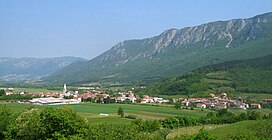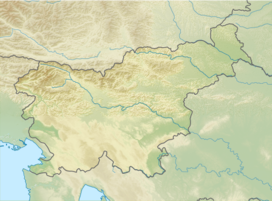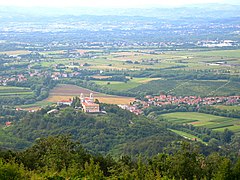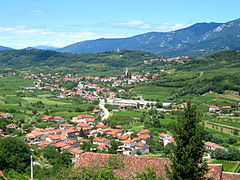Vipava Valley
This article needs additional citations for verification. (October 2009) |
| Vipava Valley | |
|---|---|
 The Vipava Valley at Podnanos | |
| Geography | |
| Coordinates | 45°52′30″N 13°54′00″E / 45.875°N 13.9°E |
The Vipava Valley (pronounced
Geography
The narrow valley of the
The Vipava Valley comprises five microregions:[1]
- The Lower Vipava Valley with the Gorizia Plain (Slovene: Spodnja Vipavska dolina z Goriško ravnino)
- The Central Vipava Valley (Srednja Vipavska dolina)
- The Upper Vipava Valley (Zgornja Vipavska dolina)
- The Vipava Hills (Vipavska brda)
- The Branica Valley (Braniška dolina)
-
1. The Lower Vipava Valley with the Gorizia Plain
-
2. The Central Vipava Valley near Ajdovščina
-
3. The Upper Vipava Valley seen from the Nanos Plateau
-
4. The Vipava Hills with the village of Goče
-
5. The Branica Valley with the village of Branik
Climate
This section needs expansion. You can help by adding to it. (February 2012) |
The region has a relatively mild, sub-Mediterranean climate. It is constantly influenced by the warm and humid southwestern wind and by the cold and gusty northeastern bora (burja) wind, especially in the cold half of the year.[2][3] Its gusts can reach speeds over 200 kilometers per hour (120 mph), hinder traffic, and damage trees and buildings.[3] In some areas, trees grow aslant with asymmetric crowns.[3]
Economy
This section needs expansion. You can help by adding to it. (February 2012) |
Due to its mild climate, the region is suitable for the cultivation of different kinds of fruits (especially
History
About 8000 BC the Vipava Valley was colonized by Illyrians, Iberians, and Ligures as well as later immigrated Celts and Etruscans (which thereafter became the Rhaetian people).[4]
In
In Medieval Times, the upper eastern part of the valley, including the town of Vipava and half of the town of Ajdovščina, used to belong to the
After
Prominent people who were born or lived in the region include the painters
See also
References
- ^ Vipava Valley Regions Archived 2011-10-04 at the Wayback Machine at MKGP.gov (in Slovene)
- ^ "Climate". Ajdovščina Tourist Information Centre. Retrieved 31 January 2012.
- ^ a b c Štrancar, Monika (June 2003). "Burja". Vipavska dolina - obrambnogeografska analiza območja [Vipava Valley – Defence-Geographic Analysis] (PDF) (in Slovenian). Faculty of Social Sciences, University of Ljubljana.
- ^ Friaul
- ^ F. Antonelli, L. Lazzarini: The first archaeometric characterization of Roman millstones found in the Aquileia archaeological site (Udine, Italy). In: Archaeometry, vol. 54, no. 1, 2012, p. 1–17, (PDF[dead link]).
- ^ Pliny the Elder: Historia Naturalis, 111-126 ff.
- ^ Pais 216 = InscrAqu-2, 2901 = AE 2007, +00264
External links
- Vipava Valley. Official site.
- Video about Vipava valley. Youtube.com.








